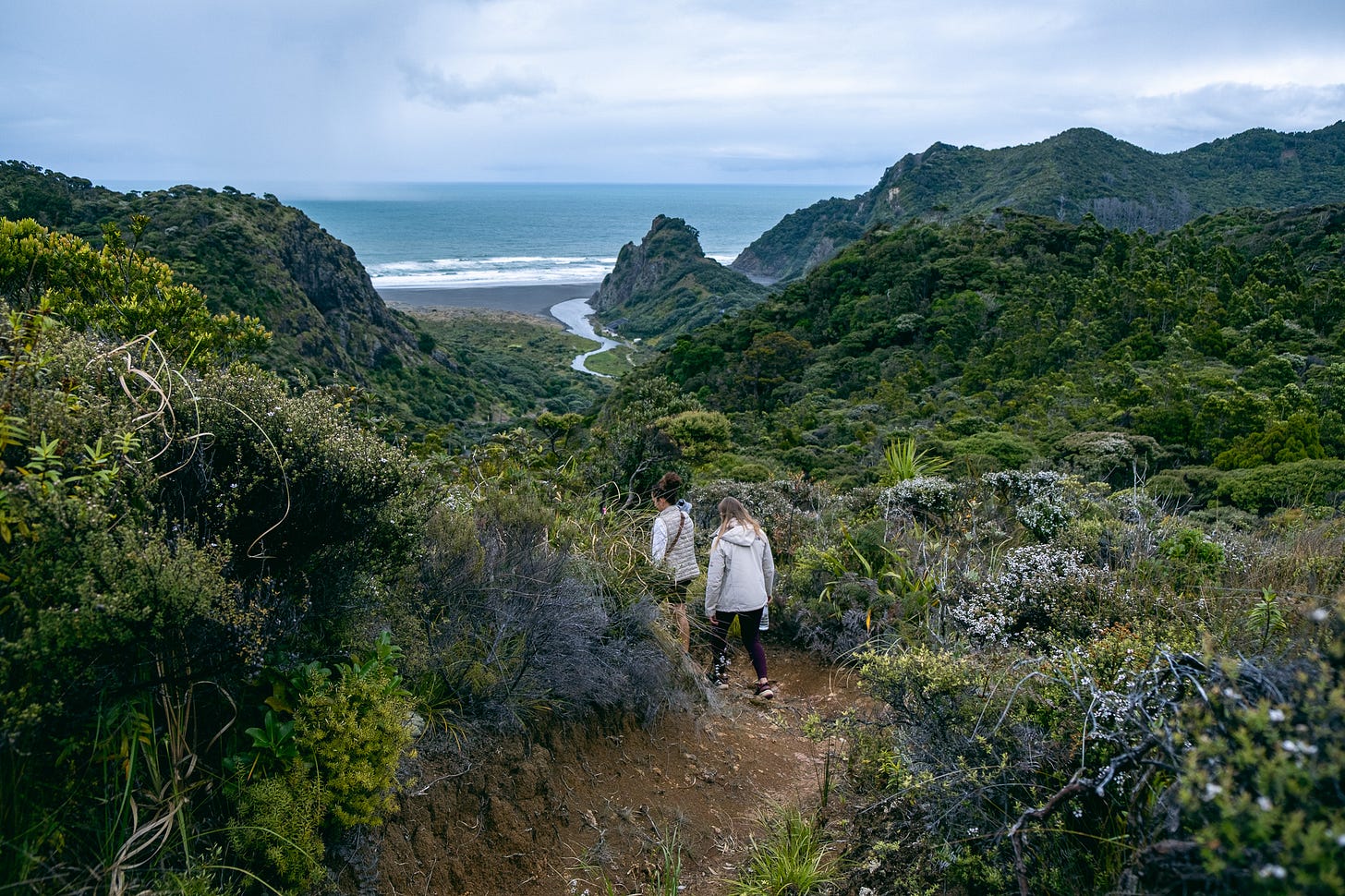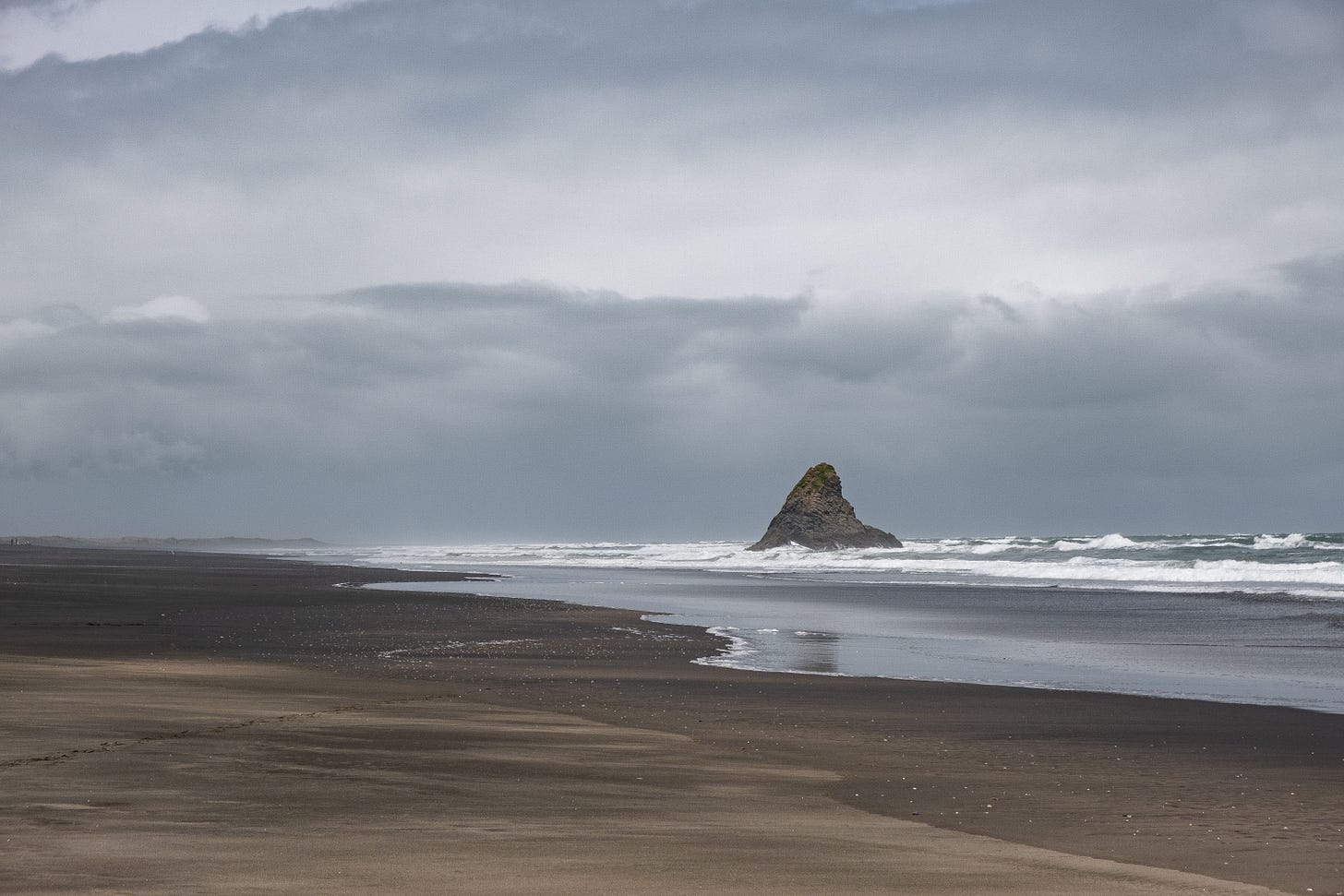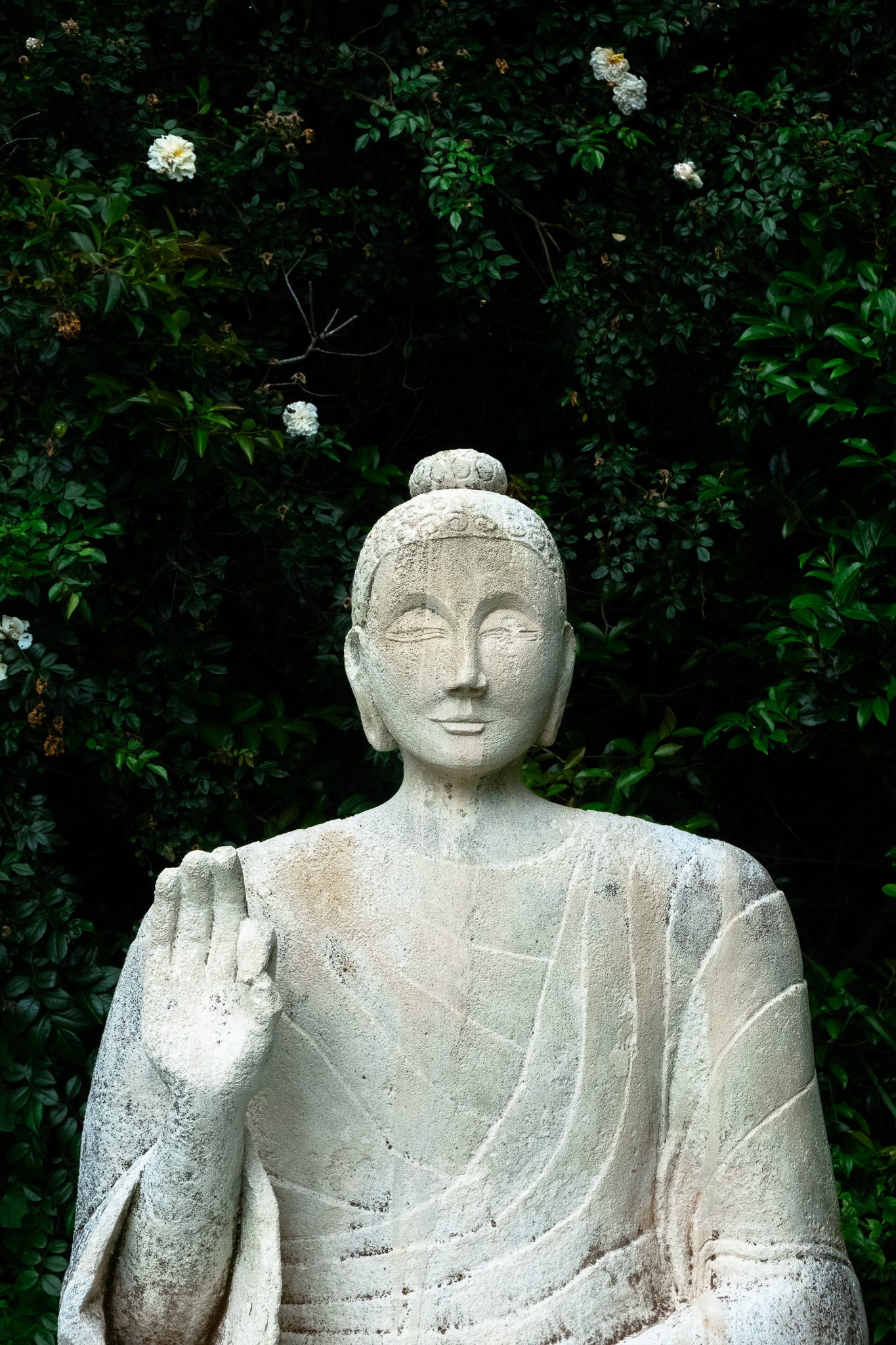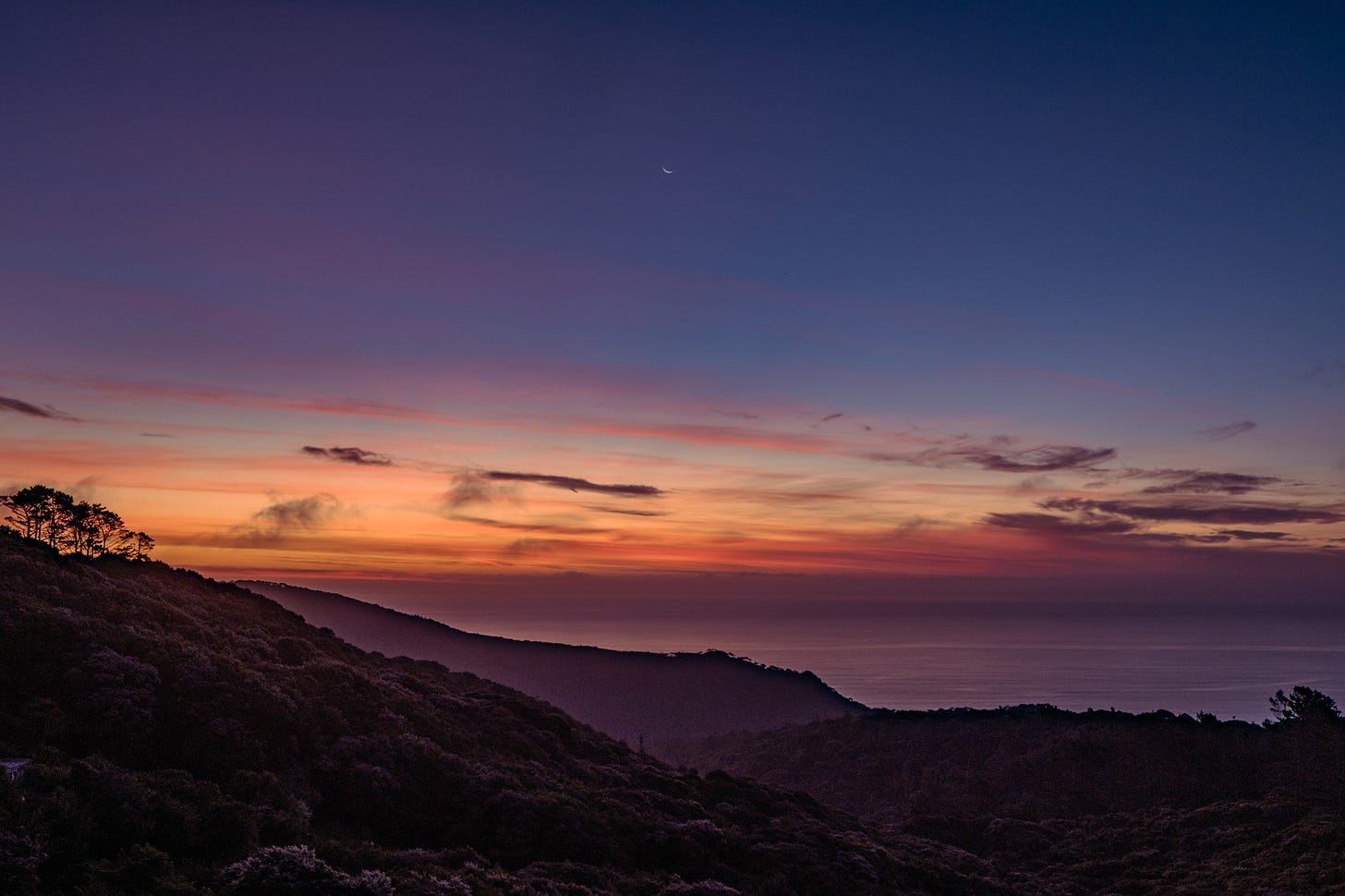Sacred Earth: un rifugio nell'ovest selvaggio
Riflessioni da Karekare, Nuova Zelanda. Novembre 2024
L’ovest selvaggio
Seduto in un tempio, con un cuscino sotto le natiche e le gambe incrociate, contemplo la maestosità della natura. Le piante si ergono come sentinelle silenziose delle antiche foreste precoloniali. Esse sono testimoni di ciò che era questo paradiso, prima che la nostalgia spingesse i coloni inglesi a trasformare le arboree colline in pascoli e prati, importando animali da caccia e allevamento per mantenere vive le proprie abitudini d’origine.
Ai piedi di questa pagina di storia si estende il maestoso Mar di Tasmania, che quando bacia le coste ovest di questo lembo di terra si guadagna il nome di Wild West, l'ovest selvaggio. Il clima qui è severo e mutevole: il calore del sole può cedere improvvisamente il passo ad un freddo penetrante, un messaggio portato dall’intensificarsi del vento, un monito ad apprezzare il presente, perché non sai mai quando tutto ciò potrebbe cambiare.
Sacred Earth: una comunità nel verde
In questo scenario di forze naturali sorge Sacred Earth, una comunità spirituale dove Valerie ed io abbiamo trascorso i nostri primi giorni in Nuova Zelanda. Il luogo è prima di tutto una foresta, punteggiata da casali in legno e vecchi camper. Qui convivono residenti e volontari, che mantengono vivo e ordinato questo spazio in cambio di un alloggio.
La vita comunitaria si esprime attraverso momenti condivisi: i pasti, le escursioni del weekend e gli incontri nel tempio. Quest'ultimo rappresenta un crocevia di culture, dove yoga, meditazione e filosofie maori e indù si intrecciano armoniosamente, offrendo a ciascuno lo spazio per coltivare la propria spiritualità.

Vivere in un tempio
Il tempio è un edificio in legno con una zona centrale completamente sgombra da oggetti e distrazioni. Un’enorme vetrata frontale si affaccia sul Mar di Tasmania, a ricordare che fuori da ogni porto sicuro c'è un mondo imprevedibile e selvaggio. Sento il vento ululare oltre le pareti di legno mentre l'aria rimane immobile all’interno. Quando apro quella vetrata che poco prima mi proteggeva dalle intemperie, mi espongo alle incertezze del mondo. Mi siedo e medito. Le mura quasi svaniscono. La mia pelle si fa corazza, la mente cerca quiete, il corpo trova stabilità nella sua posizione, nonostante ogni difficoltà.
Rifletto che quando tutto ciò che ci circonda diventa difficile e imprevedibile, è il momento di guardarci dentro e cercare le nostre risorse interiori - le sole che non scegliamo se mettere o meno in valigia, le uniche che ci accompagneranno per sempre. Insieme a queste si celano anche le debolezze, le paure e le insicurezze, che come avidi parassiti aspettano il momento di maggiore vulnerabilità per emergere e abbattere tutte le maschere che abbiamo costruito nel tempo.
Vorrei essere come questo tempio: forte di fronte alle intemperie, capace di vedere le tempeste arrivare, e flessibile nel decidere quanta energia far entrare nel mio corpo. Vorrei avere un tempio interiore sereno, libero da distrazioni, risoluto nelle proprie posizioni e flessibile nei propri desideri.
L’arte di abitare il presente
Come mi ha confidato Elia, un volontario presente qui da ormai sei mesi, il problema di molte persone quando arrivano nella comunità è che non vedono l'orizzonte, le colline e la terra dove camminano; vedono il futuro e vivono il passato. Hema, una residente da oltre un anno, mi ha ricordato invece come la vita sia imprevedibile, e come un giorno, senza rendersene conto, tutto possa cambiare. Ma soprattutto, quando questo accadrà, non sarà il denaro a salvarci dall'imprevedibile, non saranno i progetti futuri e i ricordi passati a farci navigare il presente, ma sarà piuttosto la capacità di leggere le creste delle colline, di conoscere il terreno che stiamo calpestando e, soprattutto, di conoscere noi stessi - il corpo che ci sta ospitando e permettendo di vivere questo straordinario viaggio che è la vita.
Forse è proprio questo che richiama qui tutti noi, volontari e residenti: un luogo bello e selvaggio, dove poter guardare dentro se stessi, apprezzare il lavoro della terra, connettersi con le proprie intime gioie, sogni e difficoltà. I volontari, passeggeri nel loro cammino, cercano di assorbire quanto possono per navigare più veloci nei loro futuri passaggi di vita; i residenti trovano invece luce in questa fiaccola perennemente accesa, che ricorda loro la vulnerabilità delle loro vite e dei castelli mentali che ci costruiamo.
Domande e risorse
Dopo aver letto questo articolo, ti invito a riflettere e condividere un pensiero in merito alle seguenti domande:
Hai mai pensato al tuo corpo come ad un tempio? Che forma avrebbe e come vorresti che fosse?
Come ti prendi cura del tuo tempio?
A seguire troverai una descrizione della giornata tipo a Sacred Earth e sulle pratiche promosse al tempio.
Una giornata lavorativa tipo a Sacred Earth
Il lavoro è organizzato in 3 giorni, dalle 9:00 alle 16:00, con un’ora di pausa pranzo. Solitamente il pranzo viene cucinato da Hema, una residente di origine indiana, che ama condividere con i volontari la sua cultura culinaria. Ogni venerdì i volontari si riuniscono per una cena condivisa, con l'ultimo venerdì del mese che vede la partecipazione anche dei residenti. Il lavoro consiste nella manutenzione della casa e dei giardini, spaziando dalle pulizie, alla miglioria strutturale del luogo.
Pratiche spirituali
Quasi quotidianamente ci sono incontri spirituali al tempio, che spaziano dalla meditazione, allo yoga, alla condivisione e confronto di esperienze personali. Il tempio è un luogo aperto ad ogni religione e forma di spiritualità, è un luogo culturalmente sicuro, che lascia spazio e predilige l’ascolto al giudizio.






I never thought of my body as a temple :)… maybe one day?
Condivido il pensiero di The Carpenter, ma prima di pensare che forse un giorno lo farò mi chiedo: che cosa mi porta a immaginare il mio corpo come un tempio? Forse l'idea di prendermi cura di me stessa? Non ho una risposta ma sento che il concetto si spinge oltre questa domanda